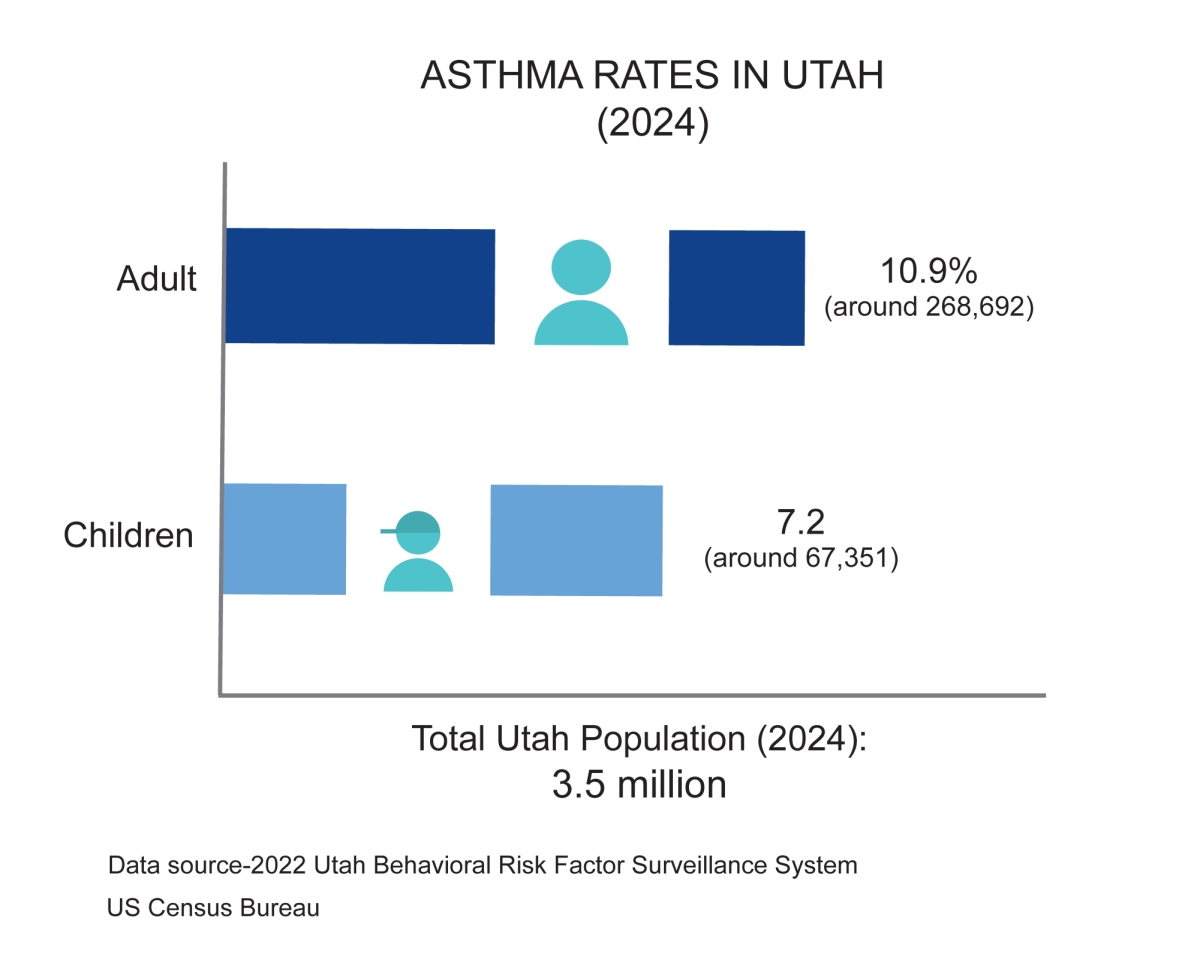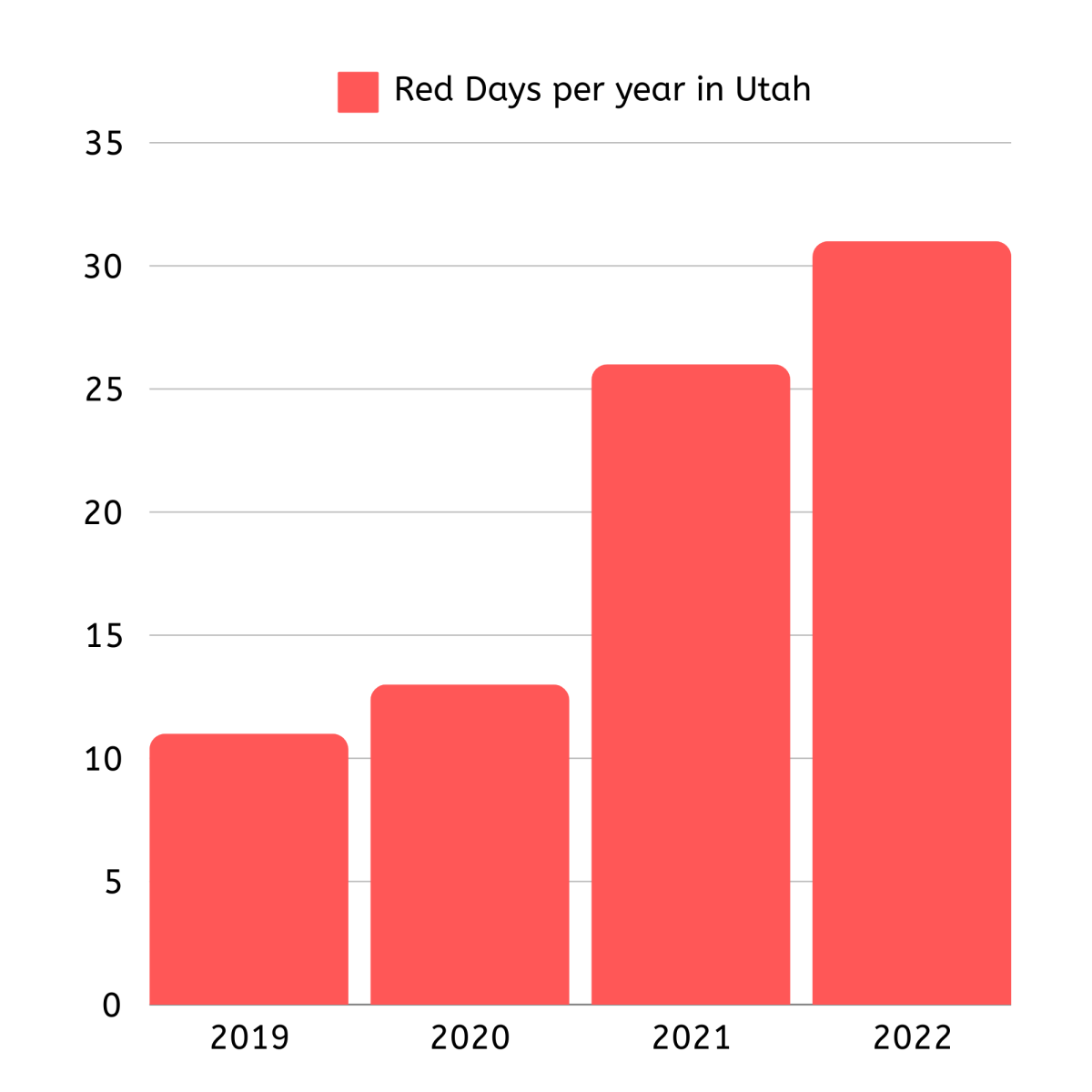Mykla Bair shouts and giggles with the other kids as they play tag, but a mask muffles her laughter. She’s the only child wearing one. Mykla Bair, 9, steps away every few minutes to cough and catch her breath. She and her brother, Easton Bair, have cystic fibrosis, a chronic, organ-damaging disease.
Cystic fibrosis, a genetic disorder that affects the lungs, digestive system and other organs, is characterized by a thick mucus buildup that causes difficulty breathing and impaired digestion. Mykla Bair was diagnosed with this debilitating disease at 6 years old. Her condition has put her in the hospital over 15 times since June 2022.
People of all ages suffer from respiratory problems in Utah. Some people can live a relatively normal life with or without treatment, while others are held captive by their extreme health conditions.
Utah meets air quality regulations most of the year. Then winter comes, and winter in Utah means inversion. Inversion occurs when cold air traps hot air beneath higher atmospheric pressure, trapping pollution.
“It feels like a death sentence,” Mykla Bair’s mother, Amanda Bair, said about living with Utah’s pollution.
The Utah Department of Environmental Quality is the primary force working to solve Utah’s pollution issues. The agency implements environmental laws and works with individuals, groups, and businesses to protect air quality.
Health impact
Trapped pollution finds its way into the lungs of vulnerable populations. According to the 2022 Utah Behavioral Risk Factor Surveillance System, around 10.9% of Utah’s 18-and-older population and 7.2% of Utah children aged 0-17 suffer from asthma. One of the leading causes of asthma in Utah is its pollution, which is exacerbated by inversion, according to the University of Utah Health.
Amanda Bair said Mykla Bair stays inside on anything but green air days, or she winds up in the hospital, facing invasive treatments which may last 8 to 12 hours each. She can go to school but must stay inside for recess and lunch. The school has provided a special room for Mykla Bair to play, color and read. Still, she hates missing outside play time with her peers and hates her cystic fibrosis.
The American Lung Association’s 2023 report shows Salt Lake City’s pollution problem worsening. Dr. Chuck Iverson, a Utah pulmonologist — a lung specialist — said that “one of the biggest contributors to the shortening of lifespan is air pollution.”
This air pollution is a growing health concern among Utahns. A 2020 study by Brigham Young University found that Utah residents lose an average of 1.1 to 3.5 years off their lifespan due to poor air quality. The same survey showed that between 2,500 and 8,000 premature deaths occur each year because of pollution. Exposure to tiny particles and other toxic pollutants can increase the risk of heart and lung diseases like congestive heart failure, heart attacks, pneumonia, Chronic Obstructive Pulmonary Disease and asthma.
These conditions account for 62% of the impact of pollution on health in Utah. The remaining 38% of health effects are stroke, cancer, reproductive damage to mothers and their children, mental illness, behavioral dysfunction, autoimmune disease, autism and other conditions — all made worse by exposure to dirty air. Most importantly, the study found cleaning the air could have immense health and economic benefits for Utah.
Utah is the second-highest state in the U.S. for the lifetime prevalence of asthma among adults, at 16.3% as of 2020. West Virginia has the highest prevalence, at 16.9%, which is partly attributed to that state’s coal mining.
The costs of pollution
The cost of Utah’s air pollution isn’t just physical. A study by 23 environmental scientists and economists found that Utah’s air pollution costs totaled $175 million to $3.3 billion annually, accounting for up to 1.7% of the state’s gross domestic product. The Centre for Research on Energy and Clean Air’s website states that the “increased risk of diseases such as asthma, diabetes, stroke and chronic respiratory diseases causes a reduced ability to work, lowers labor participation and increases healthcare costs.”
A 2019 study from the University of Utah evaluated 1,398 women who had suffered a sudden loss of pregnancy from 2007-2015 and found that the risk for spontaneous loss of pregnancy increased 16% in women along the Wasatch Front from even short-term exposure to some pollutants.
According to the University of Utah’s Bureau of Epidemiology, babies who are exposed to pollution in utero are more likely to be born premature or underweight, putting them at an increased risk for long-term health complications and death.
Particulate matter is a term for a mixture of solid particles and liquid droplets found in the air. These can be anything from car emissions to exterior paint. Particulate matter is about 3% of the diameter of human hair. Due to its small size, particulate matter can be easily inhaled, “particularly from particulate matter (PM2.5 and PM10) and ozone, as well as occupational exposures such as mine dust and respiratory illnesses like the flu, RSV, and COVID-19,” the Utah Department of Environmental Quality said.
The DEQ also states, “Utah, especially the Wasatch Front, struggles with high levels of PM2.5 and PM10, which can cause respiratory problems such as coughing, wheezing, and asthma attacks.”
According to Mykla Bair, she feels sad when she cannot breathe and even worse when she cannot do the everyday things that a 9-year-old should be able to do. She’s used to taking two breathing treatments and her medications daily. Utah air pollution makes it difficult for Mykla Bair to enjoy a full, engaging life.
Amanda Bair chose to quit her job as a surgical technician and become a stay-at-home mother because her two children with cystic fibrosis were frequently sick and she couldn’t take time off work for multiple weeks at a time. She said their illnesses sometimes last for months.
The teachers of Mykla and Easton Bair have learned how to best support their health problems and sensitivity to the Utah air. If the air outside is polluted beyond safe levels, their teachers keep them inside. Amanda Bair said it’s hard for her kids to understand that just because the air is dirty, they cannot do what they want, but it’s a necessary part of staying healthy.
“It’s a sacrifice we have to make for where we live,” Amanda Bair said. Staying inside is difficult for Amanda Bair’s other five children, but it’s how they keep the two children with cystic fibrosis safe and healthy.
Sources of particulate matter
According to the National Oceanic and Atmospheric Administration, U.S. Magnesium, the largest magnesium producer in North America, extracts the metal from the Great Salt Lake brine at a plant upwind of Salt Lake City.
“Modeling demonstrated that the chlorine and bromine emitted by the refinery were responsible for 10%-25% of regional particulate matter 2.5 during winter pollution episodes.” The DEQ also states that PM2.5 emissions and the chemicals contributing to these emissions are the primary cause of winter inversions in Utah.
“Air pollution affects the lungs and certainly people with asthma or other obstructive lung diseases like COPD. We even think that it’s tied into some of the cases of scarring in the lungs, which is something called pulmonary fibrosis, and certainly in lung cancer as well,” Iverson said. “It affects a lot of potential diseases within the lungs. There’s a lot of overlap between the lungs and allergy as well. So, people who have allergies are quite often triggered by the poor air quality too.”
Contributing approximately 6.35 tons of volatile organic compounds daily, personal care products, including perfumes, soaps and hairsprays, are the number one contributor to pollution in Utah. If it’s in a bottle or can and has a smell, it contains volatile organic compounds. These personal care products account for more emissions per day than cars. They are a significant contributor to pollution, Demetrios Pagonis, a chemical and physical scientist of Weber State, said.
“Every time someone pumps a bit of hand soap and you can smell it, you’re smelling volatile organics in the air, and you add that up across millions of people and you get a couple of tons per day,” Pagonis said. “Household products, cleaners, sprays, you name it. Everything in that cabinet under the kitchen sink that you use to clean the house has volatile organics in it.”
There are many ways of releasing chemicals into the air besides burning them inside an engine. Coatings, paints, lacquers and polishing your car puts organics in the air. The strong smell from products such as adhesives, sealants and glues used in construction is the organic compounds in the air.
Where do we go from here?
Utah actively addresses the pollution problem with various initiatives, including state incentives. Examples include The Renewable Energy Systems Tax Credit and Alternative Energy Development Incentive. However, Utahns can do a great deal to help alleviate pollution ourselves. DEQ recommends several actions, including reducing thermostat usage, using energy-efficient light bulbs, and opting for electric or hand-powered lawn tools. Simple measures such as running the clothes washer and dishwasher only when full can also help reduce energy consumption.
“If we can all do our part, limit our travel on bad air quality days, and think about ways within our own power, with our own production of pollution, to minimize those things — if we do have cars, make sure the tire pressure is adequate, the engines are tuned, so you’re reducing your CO2 production, and limit burning. If you can avoid burning with fireplaces, outdoor burns, anything like that, that can be eliminated. It does help the community,” Iverson said.


















Sally Edwards • Apr 15, 2025 at 8:38 am
Wow!